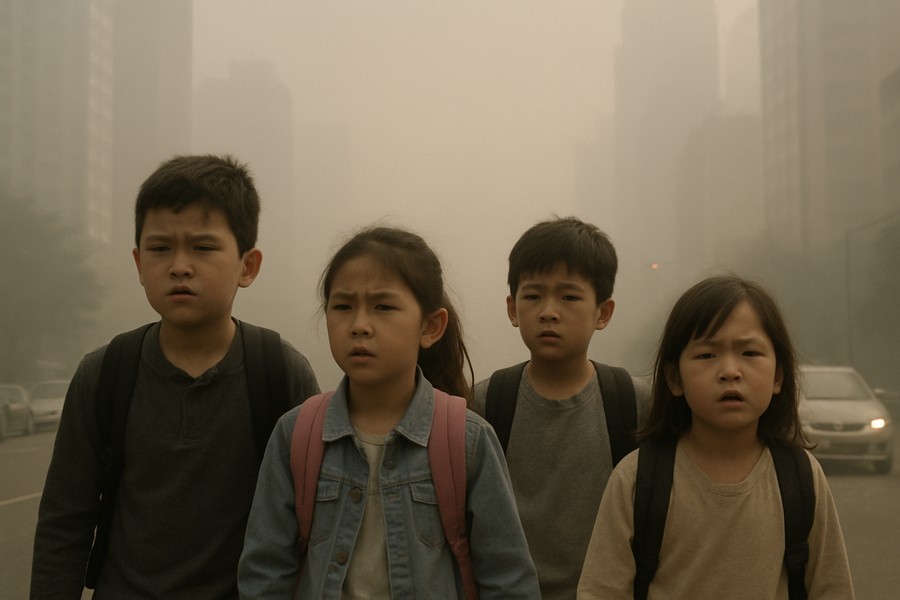
Heavily Polluted Areas Pose Threat to Children's Eyesight, Study Reveals
Children residing in areas with severe pollution could be at a high risk of suffering irreversible vision loss, according to a recent study. The research focused on nearly 30,000 school-aged children and their potential development of myopia or nearsightedness, which affects about half of all Americans. This condition results in a blurred vision of distant objects, while nearer ones remain clear.
Although most instances of myopia can be corrected with eyeglasses or contact lenses, severe forms can lead to irreversible blindness due to the development of cataracts and glaucoma.
The Link between Pollution and Myopia
The study found that severe myopia is most commonly associated with genetic factors and younger age, when eyes are more susceptible to pollutants. However, milder forms were found to be connected with risk factors that could potentially be modified.
The risk factors include environmental pollutants emitted by vehicles, industrial factories, and power plants. Access to outdoor green space was also identified as a significant factor. The researchers believe that air pollution leads to inflammation in the eyes and disrupts the tear film, a protective layer around the eyes. Additionally, these pollutants could potentially damage the cornea, causing it to scar.
Reducing Pollution to Improve Vision
The findings also suggest that reducing chemical contaminants by approximately 20% led to improvements in the vision scores of children with mild myopia. The researchers believe that decreasing pollution levels while children's eyes are still developing could potentially enhance vision levels before severe, long-lasting disease sets in.
One of the lead researchers on the study emphasized the importance of clean air not just for respiratory health, but for visual health as well. The researcher also noted that improving air quality could be a crucial strategic intervention to protect children's eyesight, especially during their most vulnerable developmental years.
Myopia: A Global Health Concern
The study involved 29,971 Chinese children from elementary, middle, and high schools. About 70% of the participants were in elementary school, and 52% were boys. Furthermore, about two-thirds of the participants had at least one parent with myopia, indicating the significant role of genetics in the condition. Additionally, 85% of the participants lived in urban areas, which typically have higher pollution levels than rural areas.
The study also measured the levels of fine particulate matter (PM2.5), microscopic particles that are emitted directly into the air from the burning of fossil fuels and wood. These particles are so tiny that they can bypass the body's natural filters, allowing them to travel into the bloodstream and cause widespread inflammation.
The researchers also examined nitrogen oxide (NO2), which is produced from burning fossil fuels and is released by vehicles, power plants, and industrial processes. The study focused on China, where the PM2.5 concentration is six times higher than the safe limit set by the World Health Organization.
Key Findings of the Study
Overall, 53% of the participants were diagnosed with myopia. The most significant factors contributing to myopia in children were found to be younger age, parents with myopia, and high levels of NO2 and PM2.5. Environmental pollution was found to be more closely related to myopia, while children with more access to green space had clearer vision.
About 81% of severe myopia cases were directly linked to non-modifiable risk factors such as genetics and younger age, whereas environmental factors only contributed to 4.3% of severe cases. However, environmental factors explained 12% of mild myopia cases, and behavioral factors like sleep and time spent outside in green space accounted for 13.6% of cases.
The researchers also utilized machine learning to simulate 'clean air' scenarios and measure the impacts of lower concentrations of air pollution. They found that reducing NO2 and PM2.5 levels by 20% improved children's overall vision scores.
The study concluded that about one-quarter of the risk in mild myopia was attributable to modifiable influences, nearly double the relative contribution seen in high myopia. The researchers underscored the need for early intervention, particularly in reducing pollution, to prevent the onset of severe myopia.
